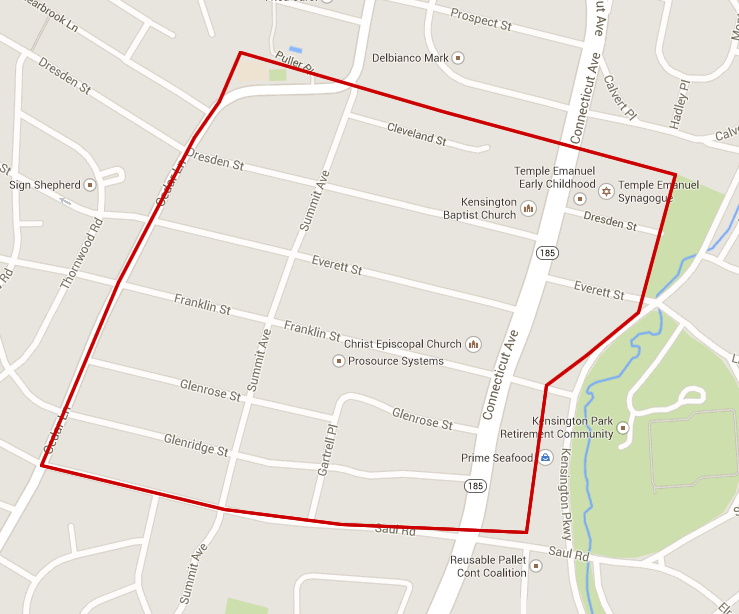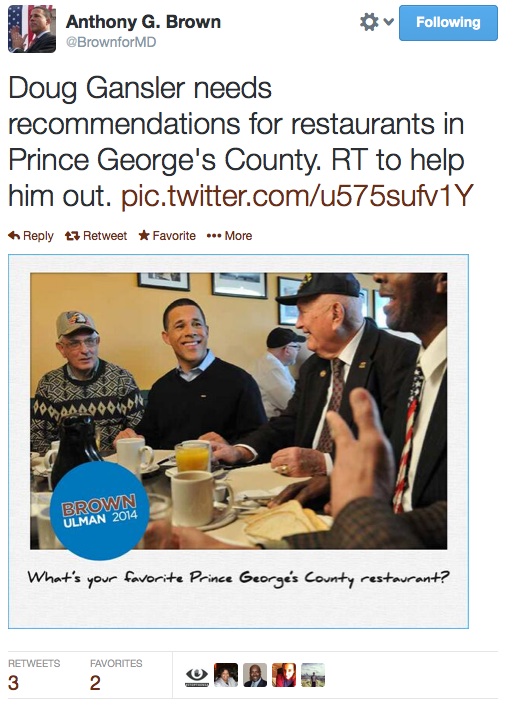
Chevy Chase, Maryland Zip Code
Even people who live in Chevy Chase get confused about all of the mini municipalities in the area. I’ve had people think I represent them, though they don’t live in my town. Here is a short guide for the perplexed.
The Chevy Chase, Maryland zip code includes all of the area in the above map. Many portions of the zip code are not part of any incorporated municipality. Much like Bethesda, these areas are a postal address and unincorporated parts of Montgomery County. Some of the western parts of Chevy Chase bleed into Bethesda and the northern parts into Kensington. When I moved back to Maryland and went to get a driver’s license, MVA refused to accept a document with “Bethesda” as the city because my other proofs of residence said “Chevy Chase.”
The Town of Chevy Chase

The Town of Chevy Chase started out as Section 4 but became the Town after it annexed Section 8 in 1976. The Town is the more or less the area between Wisconsin and Connecticut Aves. and between East-West Hwy. and Bradley La. with the commercial area on Wisconsin excluded. The largest incorporated municipality bearing the name of Chevy Chase, it has slightly more than 1000 homes and 2,800 residents and is mostly within walking distance of Bethesda. Many of the homes, particularly those located closest to Bethesda, have been redeveloped, leading the Town to adopt its building code around six years ago. (I have served on the Town Council since 2008, including two years as the Town’s mayor.)
Chevy Chase Elementary School, the Jane E. Lawton Community Center, and the National 4-H Conference Center are also located in the Town. The Town Council operated out of the 4-H prior to the construction of the Town Hall. The Town’s annual Fourth of July picnic is its most popular event.
Town services include back door twice-a-week garbage collection as well as recycling. Over 20 percent of Town residents participate in the Town’s recently established organic recycling program operated by Compost Crew. This week, the most popular town service is that we shovel the sidewalks when more than three inches of snow falls in addition to clearing the streets.
Chevy Chase Village

Chevy Chase Village is larger in area but smaller in population than the Town with just under 2000 people because its homes are mostly on bigger lots. The wealthiest municipality in Maryland, the Village has its own police department located in the Town Hall. It also has a post office located in the Village Hall. The southwestern portion of the Village is very close to Friendship Heights.
Straddling Connecticut Ave., the Village is perhaps best known these days for its speed cameras. The Village loves the cameras because they slow down traffic and generate revenue. Others are perhaps less keen. I once heard traffic along this stretch of Connecticut described as “the funeral procession.” I like to tease Village Board of Managers Chair Pat Baptiste that I try not to walk too quickly in the Village to avoid getting (another) ticket. Pat is extremely experienced in Village and County politics, having served as Chair in the past as well as on the County Planning Board.
President Obama paid a visit to George Will’s home in the Village before his inauguration in 2008 but it appears that the friendship didn’t blossom based on his columns. As the Village not only votes heavily Democratic, like most of Chevy Chase, but supported him strongly in the 2008 Maryland presidential primary, President Obama nonetheless probably feels welcome.
Section 3 of the Village of Chevy Chase

Incorporated in 1982, the Section 3 of the Village of Chevy Chase Section 3 is home to 760 people who live on 280 lots north of Bradley La. and between Connecticut Ave. and Brookeville Rd. Andy Harney is not just a neighbor but the longtime Town Manager. Smart, direct, and tough, she’s great at standing up for her town’s interests, as anyone who has ever seen her in action knows.
Village of Chevy Chase Section 5

Located just north of slightly larger Section 3, the Village of Chevy Chase Section 5 is the more southern of the two “sections” and home to 650 people. It has 223 homes and one restaurant, La Ferme. Like its southern neighbor, it incorporated in 1982.
Martin’s Additions

The Village of Martin’s Additions incorporated a little later than the two sections, its western neighbors, in 1985 and has 933 residents according to the 2010 Census. Like the two sections, its narrow streets make it tricky to navigate but also are why it’s so cute.
Friendship Heights

A triangle located between Willard and Wisconsin Ave., the Village of Friendship Heights is really a special tax district rather than a municipality. The 2010 Census reported that 4,700 people live in Friendship Heights. Unlike the municipalities described here, Friendship Heights is characterized by apartment and office buildings rather than single-family homes. The Shuttle Bus service to the Metro and the Giant is very popular.
Somerset

Halfway between Friendship Heights and Bethesda between Wisconsin Ave. and Little Falls Pkwy., the Town of Somerset has 1,200 residents. Mayor Jeffrey Slavin, who been mayor since 2008 and served on the Council previously, governs from the most attractive town hall in Chevy Chase. The Town Hall is located next to the popular Town Pool, which Somerset worked hard to renovate.
Village of Drummond
How small is Drummond? It’s too small for the Census Bureau to reveal its population. Another special tax district, Drummond is just two-thirds of one street with 43 homes. Nevertheless, the tax district is older than many of the municipalities, having been established in 1916. You’ll see Drummond just north of Somerset if you’re walking down Wisconsin Ave.
North Chevy Chase

Home to 519 people living in around 200 homes, North Chevy Chase is just south of the Beltway in the northeast quadrant of the intersection of Jones Bridge Rd. and Connecticut Ave.
Chevy Chase View

Perhaps a tad more conservative than most of liberal Chevy Chase, Chevy Chase View is just south of Kensington and is part of the greater Kensington metro area. Although the area has a long history, Chevy Chase View incorporated only in 1993. It has 920 residents.
Kensington and Garrett Park
The most excellent Towns of Kensington and Garrett Park are also considered by many to be part of Chevy Chase, though outside the zip code and with their own postal addresses. Unlike the other towns, Kensington has a commercial district. Mayor Pete Fosselman has served since 2006 and overseen the adoption of a new plan for the town. Del. Al Carr was on the Kensington Town Council before being entering the legislature. County Councilmember Nancy Floreen served as Garrett Park’s mayor before moving on to Rockville.
I’m just too tired to write more but go check out Antique Row in Kensington and Black’s Market in Garrett Park.
















